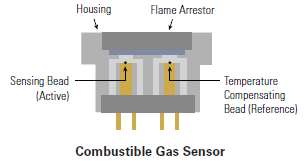
Le Ventis Pro5 s'est récemment enrichi de deux nouvelles cellules électrochimiques : la cellule hydrogène (H2) et la cellule monoxyde de carbone à plage de mesure élevée (CO gamme haute). Pour mieux comprendre cet engouement, un petit rappel sur la technologie des cellules électrochimiques peut s'avérer utile :
Les cellules électrochimiques
À la base, les cellules électrochimiques sont constituées d'une électrode spéciale placée dans une solution où le gaz cible réagit en créant un flux d'électrons. Ce flux d'électrons génère un courant qui peut être mesuré, et l'intensité de ce courant indique la quantité de gaz présente.
Contrairement à une idée reçue, ces cellules n'ont pas de date de péremption fixe. Leur durée de vie dépend de différents éléments, dont le gaz cible. Par exemple, la durée de vie d'une cellule CO dépend principalement de la quantité de gaz avec laquelle elle réagit et de sa fréquence. Une cellule CO qui travaille fréquemment au-delà de sa plage de mesure échouera à l'étalonnage beaucoup plus rapidement qu'une cellule CO qui n'est touchée qu'occasionnellement par du gaz en faible concentration.
Les cellules CO en action
Jusqu'à présent, le Ventis Pro5 offrait diverses options de détection du CO pouvant lire jusqu'à 2000 ppm. Cependant, certaines industries peuvent produire des quantités extrêmement élevées de CO, bien au-delà de cette plage. Il s'agit notamment de la fabrication de l'acier, en particulier dans les hauts fourneaux, du raffinage du pétrole lors du craquage catalytique et du reformage, de la production chimique de substances telles que le méthanol et le formaldéhyde, des fours à coke lors de la production de coke à partir du charbon, des usines de pâtes et papiers utilisant des chaudières de récupération de la liqueur noire et des centrales électriques à combustion utilisant du charbon ou des combustibles issus de la biomasse.
Avec l'introduction de la cellule CO gamme haute, le Ventis Pro5 peut désormais détecter des concentrations de CO allant jusqu'à 9 999 ppm, protégeant ainsi la cellule d'une usure prématurée.
Lutte contre les interférences croisées
Avec la technologie électrochimique, chaque cellule est conçue pour réagir à un gaz spécifique. Cependant, d'autres gaz peuvent parfois déclencher une réaction avec l'électrode de la cellule, provoquant une lecture sur la cellule. C'est ce qu'on appelle « l'interférence croisée ».
Les cellules CO ordinaires peuvent subir une interférence croisée avec H2, qui peut déclencher une lecture sur le détecteur de CO égale à 22 % de la concentration de H2. Pour cette raison, Industrial Scientific propose une cellule de CO à faible interférence H2 (CO/H2 faible), dont la plage est comprise entre 0 et 1 000 ppm. Cependant, cette cellule affichera toujours une lecture de CO égale à 3 % de la concentration de H2. Si l'H2 est présent en faible quantité, cette sensibilité croisée est négligeable. Cependant, si les industries produisent de l'H2 en grande quantité, la cellule de CO pourrait déclencher une fausse alarme en raison des concentrations plus élevées d'H2 présentes.
Les cellules H2 en action
En raison du potentiel d'interférence croisée dans les applications où le risque de présence de CO et d'H2 existe, le Ventis Pro5 doit être configuré avec un cellule CO/H2 bas, ainsi qu'une cellule H2 pour aider à identifier si les lectures de CO sont vraies ou fausses.
Les industries qui impliquent à la fois du CO et de l'H2 comprennent le raffinage du pétrole, où des processus tels que l'hydrocraquage et la désulfuration utilisent de l'hydrogène et génèrent du CO comme sous-produit ; la fabrication de produits chimiques, en particulier la production de méthanol et d'ammoniac ; la fabrication d'acier, où les hauts fourneaux traditionnels produisent du CO et où les nouvelles méthodes plus écologiques utilisent de plus en plus l'H2 ; les fours à coke, qui génèrent à la fois du CO et de l'H2 ; et la production de gaz de synthèse (syngaz), qui est un mélange de CO et d'H2 et qui est utilisé dans la création d'une variété de produits chimiques et de carburants.
D'autres industries peuvent bénéficier d'une cellule H2, notamment les usines d'électrolyse, qui divisent l'eau en H2 et O2 par électrolyse, les énergies renouvelables et les centrales nucléaires avancées, qui peuvent produire de l'H2 par électrolyse à haute température ou par des processus thermochimiques.
En outre, une cellule électrochimique H2 mesure le gaz en ppm, jusqu'à 2 000 ppm. Cela permet de détecter l'H2 en petites concentrations, bien en dessous de sa limite inférieure d'explosivité (LIE), qui est de 4 % vol, soit 40 000 ppm.
Pour les applications où l'H2 doit être détecté jusqu'à sa LIE, une cellule de diffusion catalytique est parfaite. Dans le Ventis Pro5, l'association d'une cellule H2 à la LIE permettra au détecteur non seulement d'identifier la présence d'H2 en petites quantités, mais aussi d'avertir les utilisateurs lorsque la concentration d'H2 a atteint un niveau si élevé que l'environnement est exposé à un risque de combustion.
Cliquez ici pour contacter un expert et en savoir plus.



